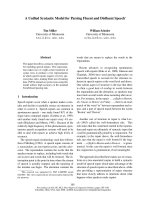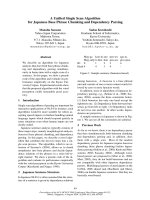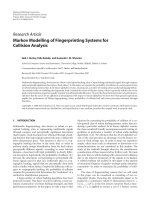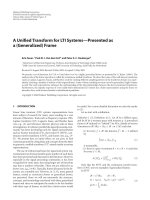Báo cáo toán học: "A unified view of determinantal expansions for Jack Polynomials" pptx
Bạn đang xem bản rút gọn của tài liệu. Xem và tải ngay bản đầy đủ của tài liệu tại đây (128.77 KB, 11 trang )
A unified view of determinantal expansions for Jack Polynomials
Leigh Roberts
1
School of Economics and Finance
Victoria University, P. O. Box 600
Wellington, New Zealand
Submitted: September 28, 2000; Accepted: December 29, 2000
AMS Subject Classification: 05E05
Abstract
Recently Lapointe et. al. [3] have expressed Jack Polynomials as determinants in monomial
symmetric functions m
λ
. We express these polynomials as determinants in elementary
symmetric functions e
λ
, showing a fundamental symmetry between these two expansions.
Moreover, both expansions are obtained indifferently by applying the Calogero-Sutherland
operator in physics or quasi Laplace Beltrami operators arising from differential geometry
and statistics. Examples are given, and comments on the sparseness of the determinants
so obtained conclude the paper.
1 Introduction
1.1 Notation
The partition λ has weight w(λ). The conjugate partition to λ is denoted by λ
, while the
transpose of a matrix A is denoted by A
T
. Variates are denoted by x
1
,x
2
, ,x
n
,with
D
i
= ∂/∂x
i
;andw = w(λ)=w(κ)= throughout.
The dominance (partial) ordering is denoted by ≤ :thusκ =(k
1
,k
2
, ) ≤ λ =
(l
1
,l
2
, ) ⇔ k
1
+ k
2
+ + k
i
≤ l
1
+ l
2
+ + l
i
for all i. The conventional total
1
Thanks are due to Peter Forrester for commenting on an early draft, and an anonymous referee who
simplified the structure of the paper and suggested improved proofs of Lemma 7 and Theorem 8. Any
errors remain the responsibility of the author.
the electronic journal of combinatorics 8 (2001), #R3 1
ordering of partitions, viz. the reverse lexicographic ordering (RLO), is denoted by
R
≤ :
hence (4)
R
≥ (3, 1).
The m
λ
functions are stacked into a column vector M in RLO, so that the ordering of the
indices of the vector elements from the top is (w), (w − 1, 1), (w − 2, 2), (w − 2, 1, 1), .
There is an analogous stacking of the e
λ
functions into a column vector E.
1.2 Overview
In [3] the Calogero-Sutherland operator is given by Lapointe et. al. as:
H
(α)
= H =
α
2
n
i=1
(x
i
D
i
)
2
+
1
2
n
i,j=1
i<j
x
i
+ x
j
x
i
− x
j
(x
i
D
i
− x
j
D
j
) . (1)
Following Stanley [6, p. 84], we define the operator:
L
(α)
= L =
α
2
n
i=1
x
2
i
D
2
i
+
n
i,j=1
i=j
x
2
i
x
i
− x
j
D
i
(2)
which we shall call the quasi Laplace Beltrami operator. The operators will be denoted
by H and L except in §3 where the more precise notation H
(α)
and L
(α)
is called for.
When α = 2, the operator L is the Laplace Beltrami operator of differential geometry
for GL(n, R) acting on cosets of the orthogonal group O(n) (see i.a. [1, p. 386], [2]). For
α = 1 the Jack Polynomials correspond to the Schur functions, while in the case α =1/2
they provide zonal polynomials for the skew-field of the quaternions ([4, pp. 440, 446]).
A comparison of (1) and (2) soon reveals the first half of the relation
H−L=
α − n +1
2
i
x
i
D
i
=
w
2
(α − n +1). (3)
For symmetric homogeneous polynomials, the operator
i
x
i
D
i
amounts to multiplication
by w, as is most easily seen by using as basis the power symmetric functions p
λ
(for the
definition of which see e.g. [6, p. 77], [4, p. 23]). For the purposes of this paper, then, H
and L differ by a constant, given in the second half of (3).
This paper encompasses the basic relations (4), (5), (6) and (7).
H J
λ
= d
λ
J
λ
L J
λ
= c
λ
J
λ
. (4)
the electronic journal of combinatorics 8 (2001), #R3 2
The equations in (4) are to be found in [3] and [6, p. 77] respectively, with eigenvalues
given explicitly in (8) and (9).
The relation LM =Ω
lm
M breaks down into:
L m
λ
= c
λ
m
λ
+
λ>κ
(Ω
m
u
)
λκ
m
κ
. (5)
Lapointe et. al. [3] work out Hm
λ
, and find an equation of the form of (5) except that c
λ
is replaced by d
λ
. From [3] we know that Ω
m
u
is upper triangular with zero diagonal, and
in addition does not depend on α.
In similar vein LE =Ω
le
E decomposes into:
L e
λ
= c
λ
e
λ
+
κ>λ
(Ω
e
l
)
λκ
e
κ
. (6)
Again, for the application of H to e
λ
, the only alteration to the right side of (6) would
be a change of c
λ
to d
λ
. One of the main aims of this paper is to deduce the form of Ω
e
l
from that of Ω
m
u
, which is given in the next equation.
Ω
e
l
T
= −α Ω
m
u
, (7)
thereby justifying the suffix l,sinceΩ
e
l
is lower triangular.
From (4), J
λ
is an eigenfunction of both operators, and the cited papers providing the
form of the operators in (1) and (2) also provide the corresponding eigenvalues:
c
λ
=
n −
α
2
w −
jl
j
+
α
2
l
2
j
(8)
d
λ
= c
λ
−
w
2
(n − α − 1) . (9)
The difference between the eigenvalues naturally mirrors that between the operators in
(3), and depends on λ only through its weight.
The determinantal expression for J
ρ
in terms of the m
λ
functions is given in [3]. Related
work was done in [5] with both basis functions for the special case of zonal polynomials
(α = 2), although results were not expressed as determinants.
In §2 the expansions of J
ρ
as determinants in e
λ
and m
λ
functions are given. The basic
symmetry between these expansions is exhibited in §3, in which (7) is proved. The
remaining technical work in the paper is the proof that the coefficient of e
λ
in (6) is
indeed c
λ
, which is undertaken in Theorem 8. An extended example in §5 and final
comments conclude the paper.
the electronic journal of combinatorics 8 (2001), #R3 3
2 Determinantal forms in e
λ
and m
λ
functions
Lemma 1
Let
J
ρ
=
κ
j
m
ρκ
m
κ
=
κ
j
e
ρκ
e
κ
.
Then j
m
ρκ
=0unless ρ ≥ κ ; and j
e
ρκ
=0unless κ ≥ ρ
. Moreover j
m
ρρ
=0and j
e
ρρ
=0.
Proof 1
The statements for the m
λ
functions are well-known (e.g. [4, pp. 326, 379], [6, p. 77]).
The conclusions for the e
λ
functions then follow directly by noting (from [7, p. 43] or [4,
p. 20], i.a.) that, for suitable constants v
κσ
:
m
κ
= e
κ
+
σ>κ
v
κσ
e
σ
.
The proof of Lemma 2 is straightforward (e.g. [5, §4.4]).
Lemma 2
If κ>λ, then there is a chain κ = κ
0
>κ
1
>κ
2
>κ
t
= λ, such that adjacent
partitions differ only in 2 elements, and these elements differ by unity. That is, for each
q,
κ
q
=(k
1
, ,k
i
, ,k
j
, ) and κ
q+1
=(k
1
, ,k
i
− 1, ,k
j
+1, )
where the entries other than the ith and jth are unaltered.
Theorem 3
Let w(κ)=w(λ). Then
κ>λ⇒ c
κ
>c
λ
⇔ d
κ
>d
λ
.
Proof 3
With notation as in Lemma 2, it is easy to show from (8) that c
κ
q
>c
κ
q+1
,afterwhicha
glance at (9) completes the proof.
The following development uses the L operator and the eigenvalue c
λ
. There would be
no difference to Theorem 4 if one were instead to use H and d
λ
in this treatment. The
diagonal elements in the resulting determinants are c
ρ
− c
λ
,which≡ d
ρ
− d
λ
from (9),
while off diagonal elements would be unaltered.
the electronic journal of combinatorics 8 (2001), #R3 4
Only the expansion in e
λ
functions is derived. The analogous expansion in m
λ
functions
duplicates the result derived in [3], and both expansions are listed in Theorem 4.
Let J
ρ
=
κ
j
e
ρκ
e
κ
= j
T
E in an obvious notation. Then
L J
ρ
= L j
T
E = j
T
L E = j
T
Ω
le
E.
But from (4) one has
L J
ρ
= c
ρ
J
ρ
= c
ρ
j
T
E
from which
j
T
Ω
le
− c
ρ
I
E =0,
where I denotes the identity matrix. The e
λ
functions are functionally independent, so
that
j
T
Ω
le
− c
ρ
I
=0. (10)
Now, from Lemma 1, j
e
ρκ
= 0 unless κ ≥ ρ
. In the matrix Ω
le
− c
ρ
I, we therefore omit
all rows and columns indexed by partitions σ such that
ρ
R
>σ;orσ
R
>ρ
and σ >ρ
.
The matrix resulting from these deletions is Ω
e
ρ,0
. It is lower triangular, with zero in the
last diagonal element, but no further zeroes along the diagonal, by virtue of Theorem
3. The vector of coefficients j is likewise reduced, albeit without change of notation;
consistent with this, the vector E is truncated, also without changing notation.
In fact the last column of Ω
e
ρ,0
is zero. One can utilise the final diagonal element to
normalise J
λ
, or one can insert E into that vacuous final column. Setting z to be a
column vector of zeroes save for unity in the final position, we have respectively:
j
T
Ω
e
ρ,2
= j
T
Ω
e
ρ,0
+(0|z)
=(0, 0, 0, ,0,N)=Nz
T
where j
e
ρρ
= N andthe0in(0|z) is a zero matrix of the appropriate order; and
j
T
Ω
e
ρ,1
= j
T
Ω
e
ρ,0
+(0|E)
= J
ρ
z
T
.
With a non-zero final diagonal element, the matrices Ω
e
ρ,1
and Ω
e
ρ,2
are non-singular from
Theorem 3, and
j
T
= Nz
T
Ω
e
ρ,2
−1
= J
ρ
z
T
Ω
e
ρ,1
−1
.
The two inverse matrices have proportional final rows, since the cofactors are identical.
Therefore
J
ρ
=
N
det
Ω
e
ρ,2
det
Ω
e
ρ,1
.
the electronic journal of combinatorics 8 (2001), #R3 5
A similar development in m
λ
functions serves to corroborate the results in [3]. Combining
the two results yields the following theorem, and examples of the expansions are provided
in §5.
Theorem 4
Using the above notation we have
J
ρ
=
j
e
ρρ
det
Ω
e
ρ,2
det
Ω
e
ρ,1
=
j
m
ρρ
det
Ω
m
ρ,2
det
Ω
m
ρ,1
, (11)
in which the definitions of Ω
m
ρ,1
and Ω
m
ρ,2
are analogous to those of Ω
e
ρ,1
and Ω
e
ρ,2
.
3 Symmetry between the operator matrices for m
λ
and e
λ
functions
A referee’s suggestion to use Macdonald’s ω
α
operator in the proof of Lemma 7 shortened
the paper considerably.
Theorem 5
Define operator matrices Ω as follows:
L
(α)
M =Ω
lm
(α) M L
(α)
E =Ω
le
(α) E (12)
and break them up into diagonal and off-diagonal portions
Ω
lm
(α)=D
lm
(α)+Ω
m
u
(α)Ω
le
(α)=D
le
(α)+Ω
e
l
(α) ,
where D matrices are diagonal; and Ω
e
l
(α) and Ω
m
u
(α) have zero diagonals.
Then Ω
m
u
is upper triangular, and does not depend on α. Moreover
Ω
e
l
(α)=−α Ω
m
u
T
. (13)
Proof 5
As already discussed just after equation (5), the matrix Ω
hm
is known from [3]. Given
that discussion, the proof is immediate from Lemma 7, noting that the terms involving
the identity matrix in (16) and (17) naturally have no impact off the diagonal.
Lemma 6
−α L
(1/α)
= ω
α
L
(α)
ω
1/α
− (1 + α)k
1
(14)
the electronic journal of combinatorics 8 (2001), #R3 6
and
−α H
(1/α)
= ω
α
H
(α)
ω
1/α
− (1 + α)(k
1
+ k
2
) (15)
where k
1
= w(n − 1) and k
2
= w(α − n +1)/2. The operator ω
α
is defined in (19).
Proof 6
In [4, p. 320] Macdonald defines an operator
α
, which he calls the Laplace Beltrami
operator, as
α
= L
(α)
− w(n − 1) = L
(α)
− k
1
.
From [4, p 330, Ex. 3] one has
ω
α
α
+ α
1/α
ω
α
=0,
or equivalently
−α
1/α
= ω
α
α
ω
1/α
.
Now the left side of (14) becomes
−α L
(1/α)
= −α
1/α
+ k
1
= ω
α
α
ω
1/α
− k
1
α = ω
α
L
(α)
ω
1/α
− k
1
(1 + α) ,
agreeing with the right side.
From (3) we have that H−L= k
2
,sothat
α
−H= −k
1
− k
2
, and the second result
(15) is proved similarly.
Lemma 7
Ω
le
(α)=−α Ω
lm
(1/α)
T
− k
1
(1 + α)I (16)
and
Ω
he
(α)=−α Ω
hm
(1/α)
T
− (k
1
+ k
2
)(1 + α)I. (17)
Proof 7
We take as given the inner product .,.
α
used to define the Jack polynomials, with
respect to which they are mutually orthogonal (see [6, p. 77], [4, Ch. VI, §§1, 10]). The
treatment here and notation follow that in [4, p. 378].
With respect to .,.
α
, the set of functions {g
(α)
µ
} are defined as those which are dual to
the m
λ
functions. That is,
g
(α)
µ
,m
λ
α
= δ
µλ
. (18)
The operator ω
α
is defined as
ω
α
g
(α)
µ
= e
µ
, (19)
the electronic journal of combinatorics 8 (2001), #R3 7
and satisfies the following identity:
ω
α
ω
1/α
=1. (20)
Having listed the properties of the operator ω
α
we proceed to the proof itself. From (12)
we may write
L
(α)
m
κ
=
ρ
Ω
lm
(α)
κρ
m
ρ
. (21)
The fact that the L
(α)
operator is self adjoint with respect to the inner product .,.
α
(see e.g. [8, p. 112]) allows us to write
L
(α)
g
(α)
λ
,m
κ
α
= g
(α)
λ
, L
(α)
m
κ
α
=
Ω
lm
(α)
κλ
, (22)
from which the following is immediate:
L
(α)
g
(α)
λ
=
κ
Ω
lm
(α)
κλ
g
(α)
κ
. (23)
The relation (19) and Lemma 6 imply
−α L
(1/α)
e
λ
= ω
α
L
(α)
ω
1/α
e
λ
− k
1
(1 + α)e
λ
= ω
α
L
(α)
g
(α)
λ
− k
1
(1 + α)e
λ
. (24)
From (23) and (19), we have
−α L
(1/α)
e
λ
= ω
α
κ
Ω
lm
(α)
κλ
g
(α)
κ
− k
1
(1 + α)e
λ
=
κ
Ω
lm
(α)
κλ
e
κ
− k
1
(1 + α)e
λ
. (25)
Interchanging α and 1/α, this expression is equivalent to
L
(α)
e
λ
= −α
κ
Ω
lm
(1/α)
κλ
e
κ
− k
1
(1 + α)e
λ
≡
κ
Ω
le
(α)
λκ
e
κ
, (26)
whence (16) follows. The proof of (17) is similar.
4 The action of L on the e
λ
functions
The final technical point, as noted in §1.2, is to show that the coefficient of e
λ
in (6) is
indeed c
λ
.
the electronic journal of combinatorics 8 (2001), #R3 8
Theorem 8
L e
λ
= c
λ
e
λ
+
κ>λ
b
λκ
e
κ
in which the coefficients b
λκ
are given in Theorem 5.
Proof 8
Let
L e
λ
= f
λ
e
λ
+
κ>λ
b
λκ
e
κ
.
From Lemma 1 one has
J
λ
= j
e
λλ
e
λ
+
ρ>λ
j
e
λρ
e
ρ
.
Then
L J
λ
= j
e
λλ
L e
λ
+
ρ>λ
j
e
λρ
L e
ρ
= j
e
λλ
f
λ
e
λ
+
ρ>λ
b
λ
ρ
e
ρ
+
ρ>λ
j
e
λρ
f
ρ
e
ρ
+
σ>ρ
b
ρσ
e
σ
= j
e
λλ
f
λ
e
λ
+
κ>λ
q
λκ
e
κ
.
But from (4) and Lemma 1 we have
L J
λ
= c
λ
J
λ
= c
λ
j
e
λλ
e
λ
+
ρ>λ
j
e
λρ
e
ρ
.
Recalling that j
e
λλ
= 0, one sees that c
λ
= f
λ
.
5 Extended example
For partitions of weight 4:
Ω
lm
=
c
(4)
44
c
(3,1)
26
c
(2,2)
2
c
(2,1,1)
12
c
(1,1,1,1)
the electronic journal of combinatorics 8 (2001), #R3 9
Ω
m
(4),0
=
04 4
c
(3,1)
− c
(4)
26
c
(2,2)
− c
(4)
2
c
(2,1,1)
− c
(4)
12
c
(1,1,1,1)
− c
(4)
J
(4)
=
m
(4)
44
m
(3,1)
−1 − 3α 26
m
(2,2)
−2 − 4α 2
m
(2,1,1)
−3 − 5α 12
m
(1,1,1,1)
−6 − 6α
The above example conforms with the example given in [3].
Ω
m
(2,2),0
=
02
c
(2,1,1)
− c
(2.2)
12
c
(1,1,1,1)
− c
(2,2)
J
(2,2)
=
m
(2,2)
2
m
(2,1,1)
−1 − α 12
m
(1,1,1,1)
−4 − 2α
Turning to the e
λ
basis functions,
Ω
le
=
c
(1,1,1,1)
−4αc
(2,1,1)
−4α −2αc
(2,2)
−6α −2αc
(3,1)
−12αc
(4)
J
(4)
=
−6 − 6αe
(4)
−4α −3 − 5αe
(3,1)
−4α −2α −2 − 4αe
(2,2)
−6α −2α −1 − 3αe
(2,1,1)
−12αe
(1,1,1,1)
Ω
e
(3,1),0
=
c
(1,1,1,1)
− c
(3,1)
−4αc
(2,1,1)
− c
(3,1)
−4α −2αc
(2,2)
− c
(3,1)
−6α −2α 0
J
(3,1)
=
−5 − 3αe
(4)
−4α −2 − 2αe
(3,1)
−4α −2α −1 − αe
(2,2)
−6α −2αe
(2,1,1)
the electronic journal of combinatorics 8 (2001), #R3 10
6 Concluding comment
Roberts [5, p. 41] has shown that the proportion p of non-zero elements in Ω
lm
behaves as
O
w
3
exp
−π
2w/3
as w →∞. The abbreviated matrices Ω
m
λ,0
and Ω
e
λ,0
will have a
higher proportion p, simply because omitted rows and columns contain only zeroes with
the general exception of the diagonal element.
For given λ,letq denote the proportion of partitions κ
R
<λsuch that w(κ)=w(λ)
and κ <λ. From casual observation, for small w one would say that q is usually small,
even for λ high in the RLO; but for large w the value of q is likely to be much higher,
especially when λ is high in the RLO. Nevertheless one expects Ω
m
λ,0
and Ω
e
λ,0
to be sparse
in practice.
References
[1] S Helgason. Differential Geometry and Symmetric Spaces. Academic Press, 1962.
[2] A T James. Calculation of zonal polynomial coefficients by use of the Laplace Beltrami
operator. Annals of Mathematical Statistics, 39:1711–1718, 1968.
[3] L Lapointe, A Lascoux, and J Morse. Determinantal expression and recursion for jack
polynomials. Electronic Journal of Combinatorics, 7(1), 2000.
[4] I G Macdonald. Symmetric Functions and Hall Polynomials. Clarendon Press, 2nd
edition, 1995.
[5] L A Roberts. On the expansion of zonal polynomials in monomial symmetric functions.
Technical Report 98-31, School of Mathematical and Computing Sciences, Victoria
University, Wellington, New Zealand, December 1998.
[6] R P Stanley. Some combinatorial properties of Jack symmetric functions. Advances
in Mathematics, 77:76–115, 1989.
[7] A Takemura. Zonal Polynomials, volume 4 of Lecture Notes - Monograph Series.
Institute of Mathematical Statistics, 1984.
[8] N Ja Vilenkin and A U Klimyk. Representation of Lie Groups and Special Functions:
Recent Advances, volume 316 of Mathematics and its Applications.KluwerAcademic
Publishers, 1995.
the electronic journal of combinatorics 8 (2001), #R3 11









